
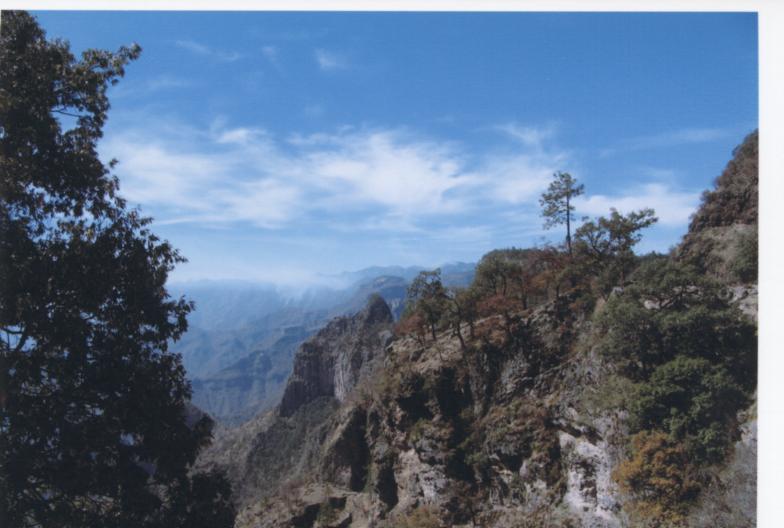
Mexico (2006)
The Treasure of the Sierra Madre
In spite of being just a day’s travel south of the American border, the Copper Canyon remains virtually unknown and unexplored by both Americans and Mexicans. Four times larger and a thousand feet deeper than the Grand Canyon in Arizona, Mexico’s Copper Canyon is one of North America’s great natural wonders. Our spectacular train journey from the Pacific Coast to the Copper Canyon highlighted not only one of the Mexico's great railroad engineering feats but also some of the world’s most awesome scenery and the most primitive aboriginal culture left in North America.
 |
 |
Chihuahua al Pacifico Train Copper Canyon
Located high in some of the most scenic and rugged parts of northwestern Mexico, the Copper Canyon can only be reached by pack mule, by a few narrow roads or along a single-tracked, cliff hanging railway. We chose to go by rail Traveling from Los Mochis on Mexico’s Pacific coast up to the high Sierra Madre Mountains, the train journey has been referred to as the “Train Ride to the Sky” and is truly one of the Western Hemisphere’s great scenic and cultural journeys.
We have taken many great train trips around the world, but the Chihuahua to Pacific railroad trip would have to rank as one of the most spectacular. Spanning 37 bridges and passing through 86 tunnels, the rail rises 8,000 feet in the 400 mile trip from Los Mochis to Chihuahua. Along the way the train passes over the 355 feet high Chinipas Bridge, crosses the 1,600 foot long Rio Fuerte Bridge, and climbs through the 6,000 foot long El Descanso Tunnel. Inside another tunnel, the train makes a full 180 degree turn before exiting at the far end. In another place, the track makes a 360 loop over itself as it climbs up to the Continental Divide.
The railroad construction was begun in 1890, twenty years after the Union Pacific railroad was completed but twenty five years before the Panama Canal was opened. It was conceived as a shorter, southern route across the North American continent measuring almost four hundred miles shorter than the Union Pacific route from Kansas City to San Francisco. Interrupted by revolutions, wars and economic crises, the railroad was not completed until 1961, almost one hundred years after it was begun. The Chihuahua and Pacific (or “Chepe” for short) is still used primarily for hauling freight but is also vitally important as a means of transportation between mountain towns for the locals. There is one, daily first-class “tourist” train that uses the tracks as well.
We were joined Los Mochis on the Gulf of California by fifteen other gringos for the seven day adventure. After a welcome dinner and overnight stay, we departed early the next morning on a semi-private rail car for the six hour trip up into the mountains. We stayed in three very different places along the way. Our first stay was Cheracahui, a small, isolated mountain village built around a 300 year old mission church. Our second stay was in a rustic ranch outside of Creel, a logging town high (8,000 feet) in the Sierras, which had the look and feel of an old frontier town. Our final, big splurge night was spent in the Posada Barrancas Mirador Hotel, cantilevered out over the canyon wall, giving us spectacular views of the canyons from our private balcony outside our room.
 |
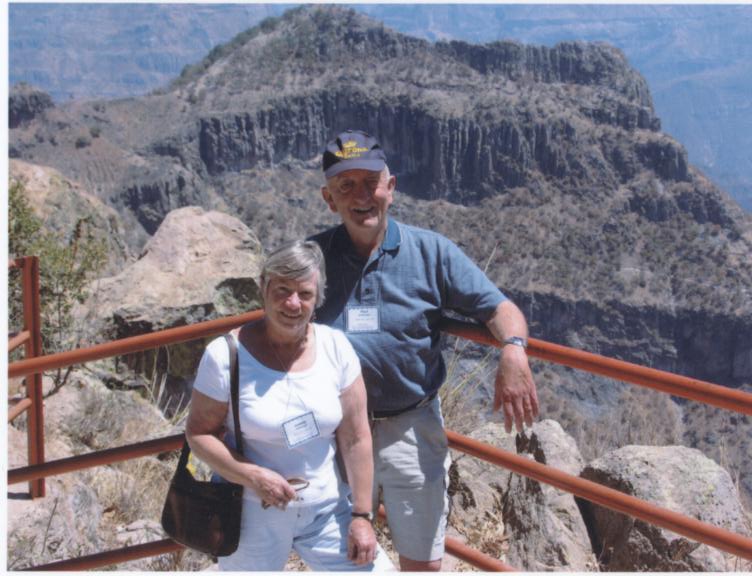 |
Val on our Mirador Hotel Balcony The Canyon Rim
Covering over 25,000 square miles, Las Barrancas del Cobre, or Copper Canyon, is actually a network of deep gorges, five river systems, six major intertwined canyons and two hundred minor ones that are cumulatively four times larger (and often deeper) than the Grand Canyon in Arizona. Unlike the Grand Canyon, the Copper Canyon walls are sloped and covered with pine forests so, although the Copper Canyon lacks many of the colorful rock formations and precipitous drops of the Grand Canyon, it makes up for it with its breathtaking size and grandeur.
An incredible variety of geographies distinguish the region - from the snow-covered mountain peaks to the sparkling lakes and enormous stands of old-growth Ponderosa pine and oak. The plunging gorges spawn wild rivers, towering waterfalls and sub-tropical forests. . Unlike the Grand Canyon, where people live either at the top or bottom of the canyon, the Copper Canyon walls are home to a fascinating and reclusive group of Indians, called the Tarahumara.
These semi-nomadic people, who number around 80,000 are considered to be the most primitive and least touched by civilization of any of the indigenous people of North America. Many are predominantly cliff and cave dwellers, who live primitively eking out a meager subsistence by raising corn, beans and livestock. Forced by the Spaniards into slave labor in the silver and gold mines in the 18th century, they rebelled and withdrew deep into the Sierras. Living in widely separated family farms, they have continued to shun civilization and avoid contact with other peoples.
With the recent growth of tourism in the Copper Canyon area, some of the Tarahumara have begun to sell their crafts to visitors. It was not unusual to walk out of our lodging early in the morning and find a mother with her children sitting on the steps outside our room offering baskets and simple jewelry for sale. Later in the day they would appear as if by magic at a picnic stop or at the end of a long hiking trail with their goods. We bought some baskets woven from the long needles of Apache pine and even a crude violin to bring home with us. It was almost impossible to resist the silent sales pitches of the beguiling little girls with their big brown eyes.
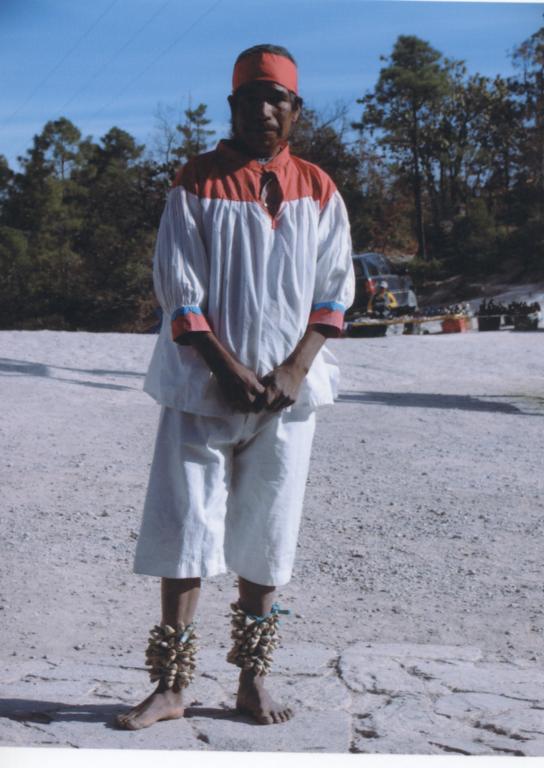 |
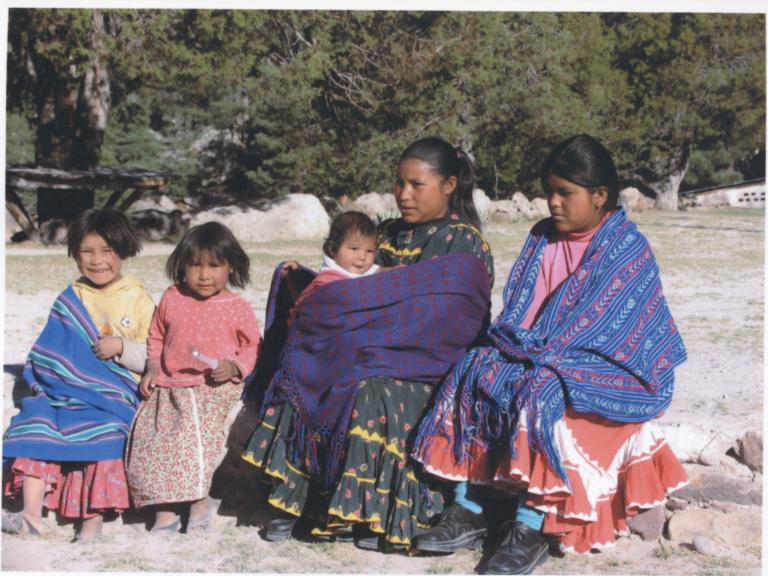 |
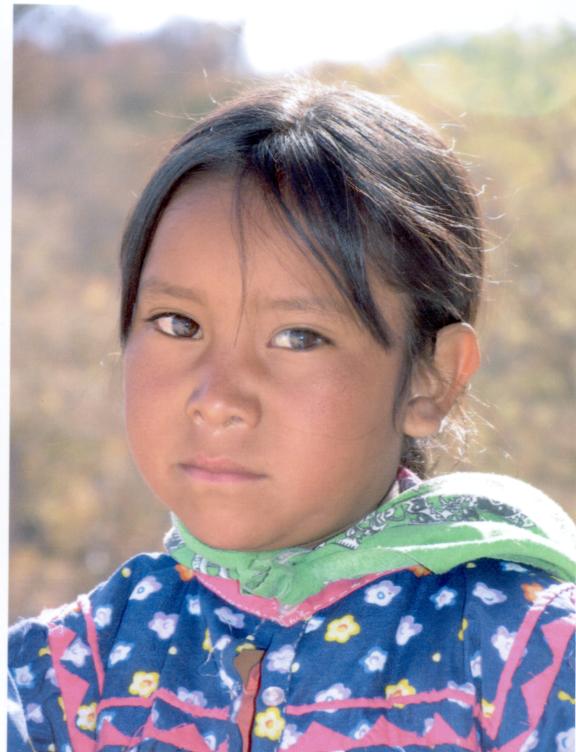 |
Tarahumara Runner Tarahumara Family Tarahumara Girl
The Taramahara still wear traditional dress. The women wear colorful, wide, multiple skirts, full sleeved blouses, head bands and shawls for carrying a child or other objects on their back. The little girls dress the same as their mothers and often carry a little brother or sister on their backs. Some of men still wear the traditional breechcloths, wool girdles, cloth head bands and loose cotton shirts.
The men take great pride in their running skills. Running up and down the steep canyon walls is an important part of their culture, not only as a means of transportation and communication but as a sport in which villages compete against one another. A few years ago group of Tarahumara (whose name means “runners”) was invited to Colorado to race against three hundred runners from around the world in a one hundred mile, high altitude, ultra marathon. Racing for the first time outside of their native surroundings and running in sandals made from discarded tires, the Tarahumara runners finished in first, second and fifth place.
We spent our days hiking through the mountains, picnicking along the canyon edge and visiting historic old churches. Since our Mexican tour guide was from the area, we were fortunate to gain access to several Tarahumara families and were able to visit their homes including one built into a cliff in the side of a canyon wall. We even had an encounter with a 105 year old Tarahumara man, who claimed to have known Pancho Villa, the famous Mexican bandit, who roamed these mountains during the Mexican Revolution of 1910.
Visiting some of the remote villages, we often had the feeling that we had been transported back into the Old West of the last century in the days when prospectors scoured the mountains for gold and silver and where Humphrey Bogart, in his classic movie ventured up into the mountains in search of “The Treasure of the Sierra Madre”. They say that there is still gold up there in the canyons. Unfortunately, we didn't find any. What we did discover, though, were the fascinating Tarahumara people and some absolutely spectacular scenery. Looking back on our trip, maybe these discoveries were our treasures of the Sierra Madre.